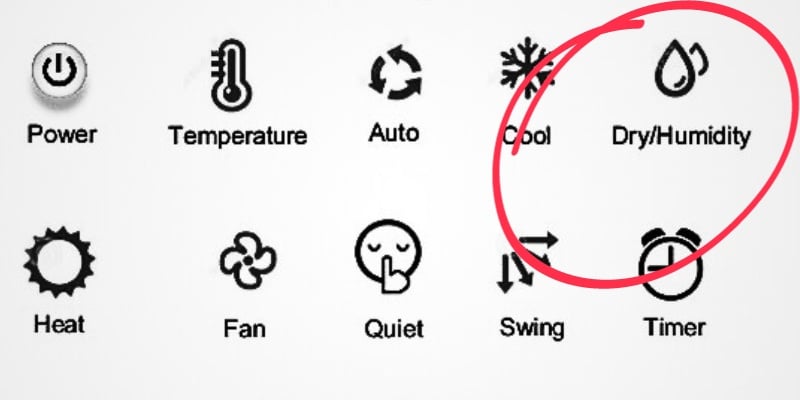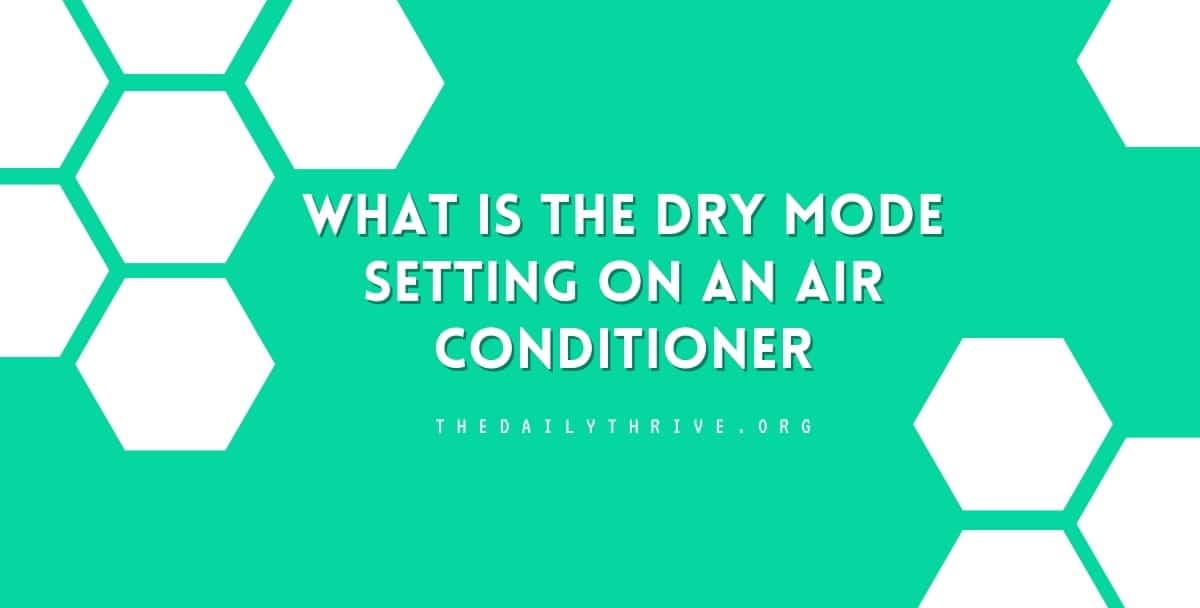In the modern era, air conditioners (AC) are not just luxury appliances but have become essential for maintaining comfort indoors, especially during extreme weather conditions. Among the various features of contemporary air conditioners, the ‘Dry Mode‘ is a notable functionality that often goes unnoticed or misunderstood. Read on to learn about your air conditioner’s dry mode setting, including why and when you should use it.
Dry mode is a unique feature found in many air conditioners, designed primarily to reduce humidity levels within a room rather than lowering the temperature. Unlike the cool mode, which focuses on cooling the room to a set temperature, the dry mode makes the indoor environment more comfortable by drawing excess moisture from the air.
This is particularly beneficial in regions with humid climates, where the air tends to hold a significant amount of water vapor.
How Dry Mode Works
The technical essence of dry mode lies in the operation of the compressor and the fan within the air conditioner.
When dry mode setting is ON, the compressor and the fan operate at lower speeds, enabling the unit to effectively remove moisture from the indoor air. The evaporator coil in the air conditioner condenses the moisture from the air, turning it into water droplets, which are then expelled from the unit.
This process transforms your air conditioner into a mini dehumidifier, ensuring the air in your space remains dry and comfortable.
Benefits of Using Dry Mode
One of the striking benefits of using dry mode is the potential energy savings. Since the compressor operates at a lower speed in dry mode, the energy consumption is significantly less compared to the cool mode, which can lead to reduced electricity bills.
Here are some of the benefits of activating the dry mode on your air conditioning unit:
- Moisture Reduction:
The dry mode significantly lowers the moisture levels in a room, combating the mugginess that often accompanies humid or rainy days. Pulling water vapor out of the air creates a more comfortable environment, allowing you to relax or sleep better. This feature is a boon during the rainy and humid season when discomfort from humidity can disrupt a peaceful night’s sleep. - Comfortable Temperatures:
Unlike the cool mode, which chills the room to a set temperature, the dry mode gently moderates the temperature, making the room feel pleasantly cool without the chilliness. Once activated, dry mode maintains this comfortable temperature, ensuring a consistent and agreeable room climate throughout the day or night. It’s perfect for those who prefer a mild, unobtrusive cooling effect rather than a stark chill. - Energy Efficiency:
Activating the dry mode translates to lower energy consumption as it requires less power to dehumidify the air than cooling it. The reduced demand for the compressor saves energy and translates to lower electricity bills. Thus, dry mode is cost-effective for managing indoor comfort while considering energy conservation. It’s a win-win, offering comfort and savings on your electricity expenditure.
The dry mode setting on your air conditioner is not just a feature; it’s a statement of intelligent climate control. It adjusts the room conditions subtly, ensuring comfort without the brunt of extreme cooling or hefty electricity bills.
Do all Types of Air Conditioning Units Have Dry Mode?
Not all air conditioning units come equipped with a dry mode. The availability of this function varies depending on the specific model and brand of the air conditioner.
Checking for Dry Mode:
You can inspect your remote control to verify whether your air conditioning unit has a dry mode. Typically, a button labeled “dry” or a water droplet symbol denotes the dry mode functionality on the remote control.

Here are some insights into the presence of dry mode across different types of air conditioners:
- Central AC Units: The feature is found in several central AC systems and ducted and ductless AC systems. This mode emphasizes moisture removal, which can be very beneficial in humid environments where excess moisture can make the space feel uncomfortably warm and clammy.
- Ducted and Split Systems: Many ducted and split system air conditioning units feature a dry mode. However, it’s not a standard feature across all models, and some may lack this function.
- Portable Air Conditioners: The dry Mode is also found in some portable air conditioning units, where it operates to remove excess humidity from the air without significantly cooling the room.
Most modern AC units signify dry mode with a water droplet symbol on the remote control. To activate it, press the “mode” button on the remote control and cycle through the options until the water droplet symbol is displayed.
It’s a simple yet effective way to combat humidity indoors, especially during rainy days or at the onset of summer.
When’s the Right Time to Turn Dry Mode On?
The utilization of dry mode is ideal during humid but not excessively hot or cold days. It’s perfect as summer approaches and during rainy days when the humidity levels are high.
The advised temperature range for using dry mode effectively is between 25°C/77°F and 30°C/86°F.
This mode is not recommended on extremely hot days as it doesn’t cool the air but merely removes moisture, making the indoor environment feel cooler.
Duration for Dry Mode Operation
It is advisable to run the dry mode for one to two hours daily to maintain a comfortable level of humidity indoors.
Keeping the relative humidity level of a room between 45% and 55% is deemed appropriate for ensuring a comfortable and healthy indoor environment. Overusing dry Mode could lead to overly dry air, adversely affecting skin, respiratory systems, and overall indoor comfort.
Dry Mode vs. Cool Mode vs. Fan Mode on Air Conditioner
The various modes of an air conditioner are designed to cater to different environmental conditions and user preferences. Here’s a comparison of Dry Mode, Cool Mode, and Fan Mode, outlining their primary functions and ideal usage scenarios:
| Mode | Primary Function | Ideal Usage Scenario | Energy Consumption |
|---|---|---|---|
| Dry Mode | Dry mode is designed to reduce the humidity level in a room rather than cooling the air. It essentially operates as a dehumidifier, removing moisture from the indoor air to make the environment more comfortable, especially in humid climates. | It’s perfect for humid days when the temperature is not too high or too low. The reduced humidity makes the air feel cooler without actually lowering the temperature. | Generally, dry mode consumes less energy compared to cool mode as the compressor runs at a slower speed. |
| Cool Mode | Cool mode’s main goal is to cool the room to a set temperature. It achieves this by running the compressor to cool down the air, and the fan to circulate the cooled air throughout the room. | It’s best used on hot days when lowering the room temperature is necessary for comfort. | Cool mode usually consumes more energy compared to dry mode as the compressor and fan run at higher speeds to cool the room down. |
| Fan Mode | Fan mode circulates the air within the room without cooling it. The compressor is turned off in this mode, and only the fan operates to keep the air moving. | It’s suitable for days when the temperature is pleasant, but you desire some air circulation to keep the indoor air fresh or to distribute heat evenly. | Fan mode consumes the least energy among the three as it doesn’t involve cooling or dehumidifying the air, just circulating it. |
In a nutshell:
- Dry mode is ideal for reducing indoor humidity without significantly altering the room temperature.
- Cool mode is your go-to for cooling down a room on hot days.
- Fan Mode is perfect for maintaining air circulation without cooling or dehumidifying.
Each mode has its place depending on the weather conditions and your comfort requirements. Understanding the differences between these modes and when to use each can help you make the most out of your air conditioning unit while also optimizing energy consumption.
Precautions
While dry mode has several advantages, it’s crucial to use it wisely.
Using the dry mode on your air conditioner for extended periods can overly dehumidify your indoor air, leading to discomfort like dry eyes, throat, skin, chapped lips, and frequent nosebleeds. It can also cause static electricity. Manufacturers usually recommend using dry mode for an hour to maintain a balanced indoor humidity.
Avoid using dry mode on extremely hot or cold days to prevent the air conditioner from losing efficiency or experiencing freeze-ups. Moreover, if the room temperature is too low, the dry mode may not function effectively, as the cold air may lead to a freeze-up on the evaporator coil.
In conclusion, the dry mode on air conditioners is a valuable feature for maintaining a comfortable indoor environment, especially during humid days. By effectively understanding and utilizing this feature, you can enhance indoor comfort and lower your electricity bills, making the most out of your air conditioner.






